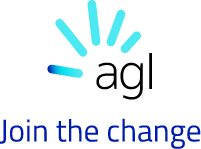People
Workforce diversity statistics
AGL has transitioned from reporting based on a bi-annual Flexible Work/Diversity and Inclusion Survey (last completed in February 2022, with an employee participation rate of 41%) to encouraging all employees to enter their diversity data into the Workday human resources information system. Data is building progressively and represents those have updated their employee records.
Indicator | AGL employees (FY24) | Australia's population |
|---|---|---|
Proportion of respondents who identify as Australian | 46.44% | 29.90% |
Number of cultures respondents identify with | 15 | - |
Number of languages spoken fluently by respondents | 46 | - |
Proportion of respondents who identify as Indigenous | 1.77% | 3.20% |
Proportion of respondents who identify as LGBTI | 8.40% | 11% |
Proportion of respondents who identify with a disability | 1.88% | 18% |
Proportion of respondents with carer's responsibilities | 27% care for their children | 59.6% |
Additional data on age and gender for FY24 is available in the data centre. |
Data is based on company-wide Workday data which was captured as of end of May 2024. Employee uptake on providing demographic data is 48%. Percentages in the table above reflect the proportion of the 48% of employees who voluntarily entered any diversity data to Workday which may not be reflective of these diversity indicators across AGL's workforce. |
Comparative data for Australia's population is based on the following sources: |
2021 Census, Australian Bureau of Statistics - Information on country of birth, year of arrival, ancestry, language and religion. |
2021 Census, Australian Bureau of Statistics - Information on Aboriginal and Torres Strait Islander peoples including language and ancestry. |
National Lesbian, Gay, Bisexual, Transgender and Intersex (LGBTI) Ageing and Aged Care Strategy (2012), Department of Health. |
Disability, Ageing and Carers, Australia: Summary of Findings, 2019, Australian Bureau of Statistics. The ABS survey defines disability as any limitation, restriction or impairment which restricts everyday activities and has lasted, or is likely to last, for at least six months. |
Household and families: Census. Reference period 2021. |
Disability, Ageing and Carers, Australia: Summary of Findings, 2019, Australian Bureau of Statistics. The ABS Survey defines Carer as a person who provides any informal assistance (help or supervision) to people with disability or older people (aged 65 years and over) |
Data does not include 39 Southern Phone Company employees, as the payroll data system used by this business is not fully integrated with AGL’s systems, accordingly comparable data is not readily available. |
Data does not include employees from Energy360 (26 employees) (acquired during FY22), as they were not integrated into AGL's human resource systems as at 30 June 2024. |
